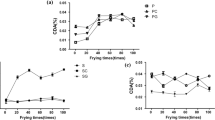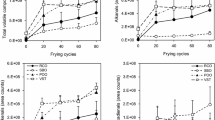Abstract
The levels of cytotoxic aldehydic products in different culinary oils, with or without thermal stress, (routine domestic or commercial frying) were determined by thiobarbituric acid method. The results showed that (i) thiobarbituric acid reactivity was much higher in edible oils rich in polyunsaturated fatty acids than those rich in saturated fatty acids or monounsaturated fatty acids, even without thermal stress, (ii) the lipid peroxide levels were in proportion to the duration of thermal stress, (iii) nature of the container used (steel, iron or teflon-coated) had no significant effect on the extent of lipid peroxidation under identical conditions of thermal stress and (iv) thermally stressed oils collected from hotels and roadside caterers contained higher levels of cytotoxic aldehydic products, when compared to oils thermally stressed under domestic frying conditions. These results suggest that dietary ingestion of thermally or autoxidatively stressed polyunsaturated fatty acid rich culinary oils is more harmful compared with those similarly treated oils rich in saturated fatty acids and monounsaturated fatty acids.
Similar content being viewed by others
References
Grootveld, M., Atherton, M.D., Sheerin, A.N., Hawkes, J., Blake, D.R., Richens, T.E., Silwood, C.J.L., Lynch, E. and Claxson, A.W.D. (1998)In vivo absorption, metabolism and urinary excretion of α, β-unsaturated aldehydes in experimental animals. J. Clin. Invest. 101, 1210–1218.
Addis, P.B. and Warner, G.J. (1991) The potential health aspects of lipid oxidation products in food. In free radicals and food additives. Arouma, O.I. and Halliwell, B., Editors. Taylor and Francis Ltd., London. p. 77–119.
Kritchevsky, D. (1991) Dietary fat and experimental atherosclerosis. Int. J. Tissue React. 13, 59–65.
Haywood, R.M., Claxson, A.W.D., Hawkes, G.E., Richardson, D.P., Naughton, D.P., Coumbarides, G., Lynch, E.J. and Grootveld, M.C. (1995) Detection of aldehydes and their conjugated hydroperoxydiene precusors in thermally stressed culinary oils and fats: Investigations using high resolution proton NMR spectroscopy. Free Radic. Res. 22, 441–482.
Luotola, M.T. and Luotola, J.E.I. (1985) Effect of α-tocopherol on the peroxidation of cod-liver oil. Life Chemistry Reports, 3, 159–163.
Briggs, G.M. and Calloway, D.H. (1984) Nutrition and Physical fitness. 11th Ed. Holt, Rinehart and Winston. CBS College Publishing, New York p. 46.
Martin, W. (1984) The combined role of atheroma, cholesterol, platelets, the endothelium and fibrin in heart attacks and strokes. Med. Hypothesis, 15, 305–322.
Kaunitz, H. (1986) Medium chain triglycerides in aging arteriosclerosis. J. Environ. Pathol. Toxicol. Oncol. 6, 115–121.
Mendis, S., Wissler, R.W., Bridenstine, R.T. and Podbielski, F.J. (1989) The effects of replacing coconut oil with corn oil on human serum lipid profiles and platelet derived factors active in atherogenosis. Nutr. Reports Int. 40, 4–11.
Kurup, P.A. and Rajmohan, T. (1994) Consumption of coconut oil and coconut kernel and the incidence of atherosclerosis: Proceedings of symposium on coconut and coconut oil in human nutrition, p. 35–59.
Kritchesky, D. and Tepper, S.A. (1967) Cholesterol vehicle in experimental atherosclerosis. Comparison of heated corn oil and heated olive oil. J. Atherosclerosis. Res. 7, 647–651.
Staprans, I., Rapp, J.H., Pan, X.M., Hardman, D.A. and Feingold, K.R. (1996) Oxidised lipids in the diet accelerate the development of fatty streaks in cholesterol-fed rabbits. Arterioscler. Thromb. Vasc. Biol. 16, 533–538.
Author information
Authors and Affiliations
Rights and permissions
About this article
Cite this article
Prabhu, H.R. Lipid peroxidation in culinary oils subjected to thermal stress. Indian J Clin Biochem 15, 1–5 (2000). https://doi.org/10.1007/BF02873539
Issue Date:
DOI: https://doi.org/10.1007/BF02873539




